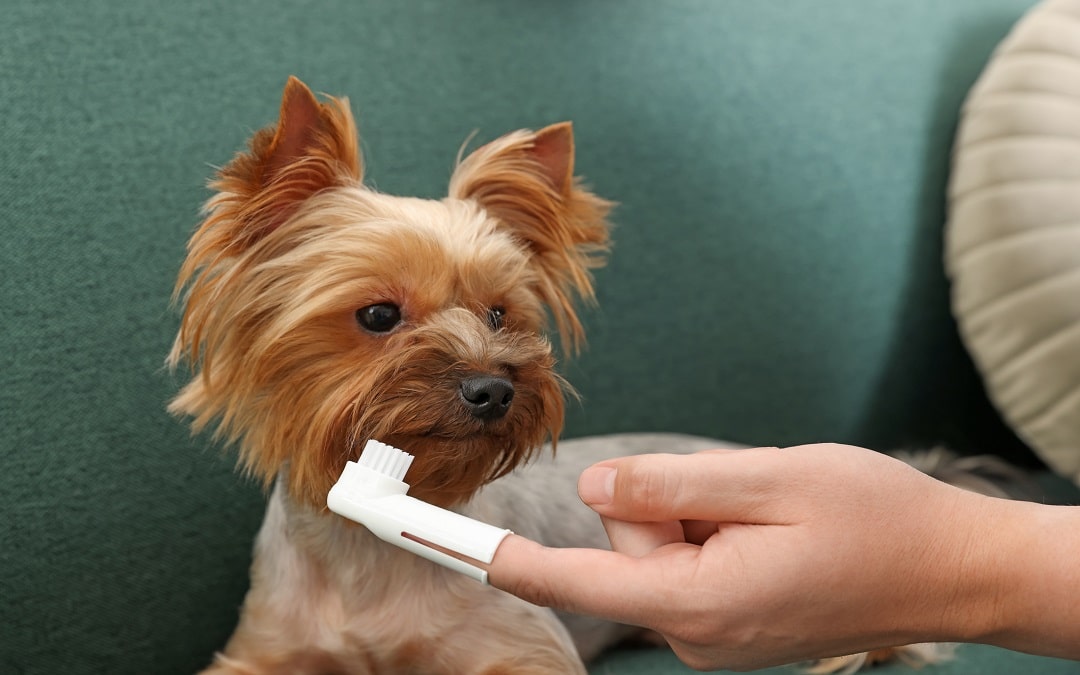Why Do You Need to Keep Your Dog’s Teeth Clean?
Like with our own teeth and gums, it is vital that we keep them clean to prevent dental and gum disease. Regular brushing prevents tartar build up from the foods we eat. This tartar is calcified food that sticks to the tooth and gum line, which allows bacteria to build up. This overtime causes tooth decay and enables teeth to break down. This is not only unsightly, but also causes pain infection that can spread. It is essential to start a dental hygiene routine at home to prevent these problems in our canine companions.
How to Clean a Dog’s Teeth
It is important that we implement dental care routines from an early age, as this familiarises your dog to this healthy habit and makes it easier to maintain. To introduce your pet to the toothbrush, you can gradually introduce it by having your finger near their mouth. These build trust over time. You should add brushing your dog’s teeth as part of a regular grooming routine.
Ensure that you have the right products — buy a canine toothpaste. There are plenty of dog toothpastes on the market that are usually chicken or beef flavoured to encourage your canine friend to accept. You can also buy canine toothbrushes that go over your finger. This makes it easier to access the back areas of the mouth. If you do not have a dog toothbrush, a child-sized toothbrush is also fine.
Put a pea sized amount of vet approved toothpaste onto your brush. Gently raise your dog’s upper lip and place the brush against the tooth. Using slow and circular motions, gently brush the teeth against the gum line at a 45-degree angle. If this is your first time brushing your dog’s tooth, only brush 1–2 teeth. Over time, you can increase the number of teeth you brush until you can brush all teeth in one session. Taking it slow with your dog is important to build trust and to encourage your pet to feel comfortable. Positive reinforcement is encouraged after the session has finished.
Signs of Dental Problems
It is vital that our pets have happy and healthy teeth and gums. Here are some signs and symptoms of dental and periodontal disease that you can look out for:
- Tartar on the tooth/gum line: this is like what we can see in humans. This yellow or discoloured build up on the tooth/gum line.
- Red/bleeding gums
- Bad odour from the mouth
- Missing/discoloured teeth
- Sensitivity: This could be to touch or foods. Your pet may refuse food or eat on one side of the mouth if there is pain or sensitivity to the area.
- Fractured teeth
Dog Dental Disease Treatment
Like in human medicine, prevention is better than a cure when it comes to dental disease. If you feel that your pet may have dental disease, they should be taken to see your vet for a full examination and treatment plan. In most cases, your dog will need a sedation to thoroughly examine the oral cavity. In some cases, X-rays may also be taken to visualise any suspected damage to the roots or bone structures.
There are many outcomes from dental disease that start from a simple scale and polish that escalate to extractions of damaged teeth. Your veterinary surgeon will discuss your pet’s dental treatment plan prior to any surgery.
Following treatment, your pet will likely need pain relief medication and potentially a course of antibiotics. You will then need to implement a hygiene routine at home to prevent any dental related issues in the future.
Tips to Keep Your Dog’s Teeth Healthy and Clean
There are many ways in which we can keep our pets’ teeth clean and healthy.
- Feeding the right food: Please discuss with your vet what the preferred diet may be. Every pet is different and there is not one food that fits all.
- Brush your dog’s teeth regularly
- Dental chews: not only are these a nice treat for your pet but can also prevent tartar build up. Please be mindful that these treats can be calorific and must be given in moderation with a healthy diet.
Final Thoughts
As we have discussed, there are many tips and tricks on how to keep your dog’s teeth and gums happy and healthy. At Anrich Vets, we offer teeth cleaning services with free dental consultations with our nurse. If you are unsure with your pet’s health or would like some help/demonstrations on how to brush your dog’s teeth, please speak to our reception team.

